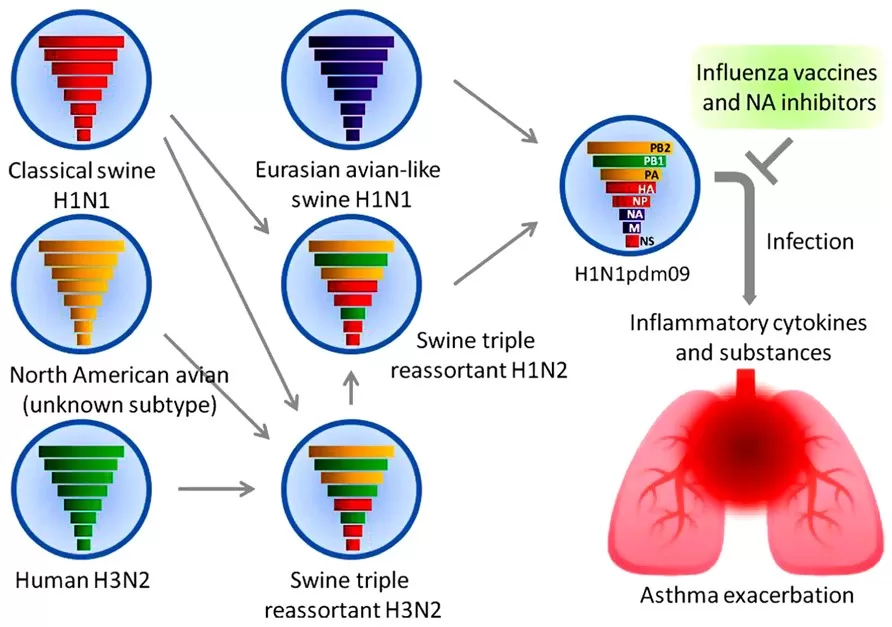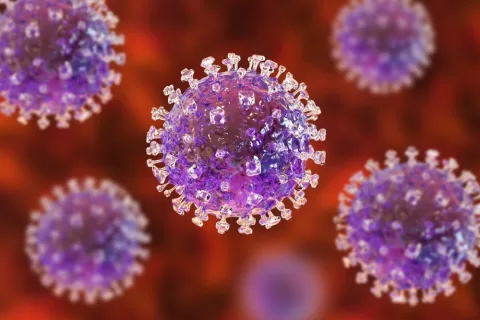H1N2v flu has recently emerged as a concern in Pennsylvania after the state reported two new infections among adults who had attended a livestock auction featuring pigs. The Centers for Disease Control and Prevention (CDC) highlighted this incident in their latest flu update, indicating that the cases are part of a broader trend of variant H1N2 infections. While this virus is not commonly seen in humans, these recent Pennsylvania flu cases have raised alarms among health officials. The H1N2 variant flu is linked to livestock flu outbreaks, emphasizing the importance of monitoring such infections closely. Health experts advise vigilance and vaccination to prevent any potential spread of variant viruses amid fluctuating seasonal flu activity.
The variant influenza strains, including the H1N2v flu, have been creating a stir in public health circles as their effects on human populations become more evident. Also known as the H1N2 variant flu, this particular strain highlights the ongoing interactions between livestock and human health, especially during events such as auctions or fairs. With reports of new cases in places like Pennsylvania, it is crucial to stay informed about these infections and their potential outbreaks. The CDC provides regular updates, addressing concerns about both seasonal flu and variant strains, reinforcing the importance of vaccination. As we navigate through the ongoing flu season, recognizing these variant strains and their implications for public health is vital.
Understanding H1N2v Flu Infection
The recent reports of H1N2v flu infections in Pennsylvania highlight the ongoing concerns surrounding variant flu strains. H1N2v, a subtype of the influenza A virus that has primarily circulated among livestock, has now made its way to humans, prompting the need for heightened vigilance. The Centers for Disease Control and Prevention (CDC) are closely monitoring the cases, which were linked to individuals who attended a livestock auction where pigs were present. This underscores the potential for zoonotic transmission of influenza viruses, particularly in settings where humans are in close contact with infected animals.
As the CDC continues to provide updates on flu activity, they have indicated that H1N2v cases, although rare, can lead to serious health outcomes. The recent infections are a reminder for livestock handlers and auction attendees to practice proper biosecurity measures. Preventive strategies such as vaccination and minimizing close contact with animals during flu outbreaks are essential to control these variant strains. Moreover, public health officials emphasize the importance of prompt medical evaluation for anyone exhibiting flu-like symptoms, especially following exposure to animals.
Recent Pennsylvania Flu Cases and Public Health Response
The Pennsylvania Department of Health recently confirmed two new H1N2v flu cases, bringing attention to the regional impact of flu outbreaks. Previously, a similar case was reported earlier in the year, illustrating a concerning trend for H1N2v infections that affect adults with ties to livestock environments. The healthcare community is actively encouraging those in affected areas to remain alert for symptoms and seek medical advice if necessary. With the CDC’s continuous surveillance and updates, residents can stay informed about the prevalence of variant strains like H1N2v, impacting public health initiatives.
In addition to monitoring H1N2v cases, the CDC has reported overall low seasonal flu activity nationwide. Despite the concerning trend in variant infections, public health measures such as increased vaccination efforts and education on flu prevention remain crucial. The CDC’s guidelines emphasize the significance of flu vaccinations ahead of the upcoming respiratory virus season, particularly for vulnerable populations. Continuing education and vigilance in communities that engage in livestock farming can significantly mitigate the spread of H1N2v and similar infections.
CDC Flu Update: Key Recommendations and Findings
In the latest CDC flu update, health officials urged the public to prioritize vaccinations against both flu and COVID-19 as we approach the respiratory season. With the potential for overlapping outbreaks, particularly as H1N2v cases arise, the emphasis on immunization becomes even more critical. Vaccination serves as the primary defense mechanism against severe flu, especially for those who may come into contact with livestock. The Advisory Committee for Immunization Practices (ACIP) has recommended that all eligible individuals, particularly those in healthcare settings or in contact with at-risk populations, receive updated vaccinations.
Moreover, the CDC’s recommendations also highlight the unique considerations for specific groups, including immunocompromised individuals and older adults, who may benefit from high-dose or adjuvanted flu vaccines. These tailored recommendations reflect the CDC’s commitment to providing equitable and effective healthcare solutions. As surveillance efforts continue, individuals are encouraged to remain informed about their vaccination status and potential flu risks to contribute to community health safety during peak flu season.
Flu Activity: Low Rates but Ongoing Surveillance
Despite the alarming news of H1N2v infections, the CDC indicates that overall seasonal flu activity remains low this year. However, continued vigilance is warranted as seasonal flu deaths have been reported, with pediatric cases underscoring the potential severity of flu infections among children. The health authorities are actively tracking trends and maintaining robust surveillance to ensure that any rise in flu cases, including variant infections, is promptly addressed.
The presence of variant influenza viruses continues to pose a challenge, particularly in light of livestock flu outbreaks that can affect public health. Increased surveillance during the offseason allows for better preparedness should cases rise. The combination of seasonal flu metrics and the emergence of new variants like H1N2v emphasizes the importance of community awareness, early intervention, and adherence to health guidelines. Seasonal changes in flu viruses, particularly in livestock-rearing regions, necessitate continuous community health education and preventive strategies.
Livestock Flu Outbreaks: A Snapshot of Risks
Livestock flu outbreaks, such as those involving the H1N2v strain, present unique challenges due to the close proximity between humans and animals in agricultural settings. These outbreaks can lead to zoonotic infections, requiring swift public health responses to prevent further transmission. The recent confirmed cases in Pennsylvania signify the importance of monitoring flu activity not just in human populations, but also in livestock where influenza strains can mutate and jump to humans.
Furthermore, livestock auction events are critical points for potential transmission, making it essential for farmers and attendees to implement proper health protocols. Educating those in the industry about signs of illness in livestock, vaccination programs for animals, and hygiene practices in handling livestock can greatly reduce the risk of outbreaks. The interplay between agriculture and public health is vital, and ongoing collaboration between state health officials and agriculture departments is necessary to mitigate these risks.
The Role of Vaccinations in Flu Prevention
As the CDC reinforces the importance of vaccination, communities must prioritize flu shots as an effective strategy to prevent both seasonal and variant flu infections. Vaccination not only helps protect individuals but also contributes to the broader public health goal of Immunity. With the ongoing threat of conditions like H1N2v, vaccines play a pivotal role in controlling potential outbreaks that can arise from livestock interactions or seasonal outbreaks.
Additionally, seasonal flu vaccines are crucial for high-risk groups, including the elderly and individuals with prior health conditions. Ensuring that these populations are vaccinated will help lower hospitalization rates and reduce the community burden during flu season. Public health campaigns must continue to promote awareness regarding vaccination availability to minimize flu’s impact on society, especially as crossover infections from animal populations present new challenges for public health.
Assessing Pediatric Flu Deaths and Health Impacts
The recent increase in reported pediatric flu deaths has added urgency to public health communications about flu prevention measures. As seasonal flu numbers trend upwards, vigilance is critical, particularly for families with children. The CDC’s statistics reveal concerning patterns that indicate the need for improved preventive strategies, including bolstering vaccination efforts and encouraging health consultations following flu symptoms in children.
Public health experts are especially focused on the detrimental impacts of flu on youngsters, given their developing immune systems. Parents are urged to remain proactive by keeping track of flu vaccinations and monitoring any signs of illness in their children. Collaborative efforts from schools and community organizations can increase awareness and education surrounding the importance of vaccinations to prevent flu-related complications, especially among vulnerable pediatric populations.
Future Implications of Obesity and Infectious Diseases
Recent studies, such as those linking childhood obesity to increased hospitalization risks during infectious diseases like dengue, raise pivotal questions about public health policy. These findings highlight the connections between obesity and the severity of infections, extending concerns to flu viruses, including H1N2v. The implications for healthcare strategies are profound, as weight management could play an essential role in improving health outcomes during flu seasons.
Addressing the obesity epidemic is crucial not only for overall health but also for reducing the impact of infectious diseases on high-risk populations. Public health initiatives emphasizing healthy lifestyles, nutrition, and awareness about the risks associated with obesity should be integral to community health strategies. By integrating these goals into flu prevention campaigns, healthcare providers can foster a comprehensive approach to mitigating the impacts of both obesity and infectious diseases.
The Need for Ongoing Research in Influenza Variants
The recent appearance of H1N2v flu infections demonstrates the importance of ongoing research into influenza variants. Understanding the genetic makeup and transmission pathways of influenza viruses that can jump from animals to humans is essential for controlling outbreaks. Current research efforts aim to track the evolution of these viruses and develop vaccines that can respond more effectively to emerging strains.
Moreover, studies investigating the population dynamics of influenza in livestock will help public health authorities design better surveillance strategies and intervention programs. Increased collaboration across agriculture, veterinary sciences, and public health sectors will be vital in addressing the complexities of influenza variants, ensuring that effective measures can be taken to prevent future zoonotic infections.
Frequently Asked Questions
What is H1N2v flu and how does it spread?
H1N2v flu is a variant influenza virus that primarily circulates among pigs and can occasionally infect humans, typically through direct contact with infected animals at livestock markets or auctions. Recent H1N2v infection cases in Pennsylvania highlight the need for awareness, especially in areas with livestock flu outbreaks.
Are there any recent H1N2v infection cases reported in Pennsylvania?
Yes, the Pennsylvania Department of Health reported two new cases of H1N2v infection, both involving adults who had attended a livestock auction. This brings the state’s total cases this year to three, as detailed in the latest CDC flu update.
What should I do if I am exposed to H1N2v flu?
If you suspect exposure to H1N2v flu, particularly through contact with pigs or at livestock events, it’s important to monitor for flu-like symptoms and seek medical advice. Early intervention can help manage H1N2v infections effectively.
How does H1N2v flu compare to seasonal flu strains?
H1N2v flu is a variant that differs from standard seasonal flu strains, largely because it is associated with livestock. Unlike common seasonal flu, H1N2v is primarily spread through contact with infected animals. However, the CDC continues to monitor both H1N2v and seasonal flu activities concurrently.
What precautions can prevent H1N2v infection during livestock auctions?
To prevent H1N2v infection at livestock auctions, wash hands frequently, avoid direct contact with animals, and stay informed about recent outbreaks. Being aware of H1N2 variant flu cases and following guidelines from health authorities like the CDC can significantly reduce risk.
Is vaccination available for H1N2v flu?
Currently, there is no specific vaccine for H1N2v flu. However, the CDC recommends annual flu vaccinations to protect against seasonal flu strains. Staying up to date with vaccinations can help safeguard public health broadly, especially in light of potential variant outbreaks.
What are the symptoms of H1N2v flu?
Symptoms of H1N2v flu include typical flu-like signs such as fever, cough, sore throat, body aches, and fatigue. In severe cases, it can lead to complications necessitating medical care. It is essential to consult a healthcare provider if these symptoms follow known exposure to H1N2v.
How does the CDC monitor H1N2v flu cases?
The CDC actively monitors H1N2v flu cases through reports from state health departments, tracking potential outbreaks, and conducting surveillance during influenza seasons. Regular CDC flu updates provide the latest information on trends and recommendations concerning variant viruses like H1N2v.
What is the public health impact of H1N2 variant flu outbreaks?
H1N2 variant flu outbreaks can pose public health challenges, particularly among individuals in close contact with infected livestock. Enhanced surveillance and vaccination efforts are crucial to mitigating the impact of both H1N2v and seasonal flu on the population.
| Key Points | Details |
|---|---|
| Recent H1N2v Infections | Two adults in Pennsylvania infected after attending a livestock auction. |
| Total Cases This Year | Total confirmed H1N2v cases in the U.S. is now three. |
| Current Investigation | Investigation ongoing; one patient hospitalized with no additional illnesses among contacts. |
| Seasonal Flu Update | Seasonal flu markers remain low with 181 pediatric deaths reported this season. |
| Vaccine Recommendations | CDC recommends updated COVID and flu vaccines for most individuals aged 6 months and older. |
Summary
The recent report of H1N2v flu infections highlights the importance of awareness around this variant type. H1N2v flu has now infected two additional adults in Pennsylvania following their exposure at a livestock auction, bringing the case count for the year to three. While seasonal flu activity remains low, it is crucial for individuals to stay informed about vaccinations and public health recommendations to prevent further spread. With ongoing surveillance and ongoing investigations, health authorities are focusing on ensuring public safety amidst evolving flu activity.
The content provided on this blog (e.g., symptom descriptions, health tips, or general advice) is for informational purposes only and is not a substitute for professional medical advice, diagnosis, or treatment. Always seek the guidance of your physician or other qualified healthcare provider with any questions you may have regarding a medical condition. Never disregard professional medical advice or delay seeking it because of something you have read on this website. If you believe you may have a medical emergency, call your doctor or emergency services immediately. Reliance on any information provided by this blog is solely at your own risk.








